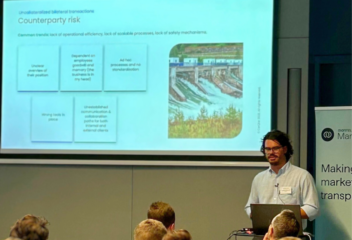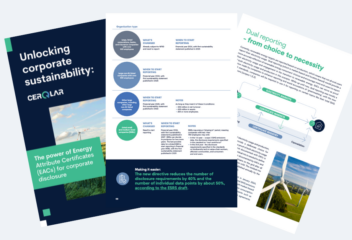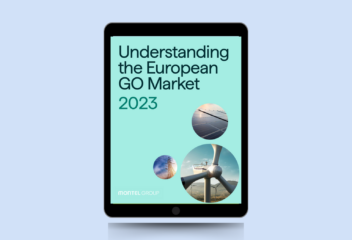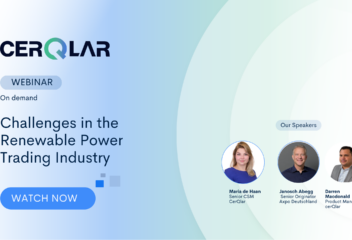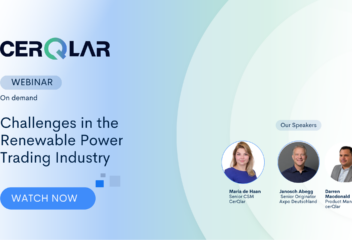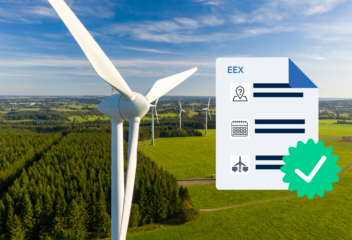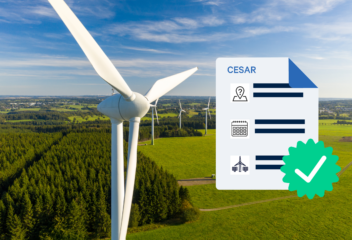Are high Guarantees of Origin prices here to stay? Highlights from Green Week 2023 webinar event
Are Guarantee of Origin (GO or GoO) certificates’ high prices here to stay? This was the opening question of the recent webinar about the future of Guarantee of Origin prices held during the Green Week event by Montel Group.
Manuela Rodriguez, Legal Counsel at CerQlar, was one of the participants while Olav Vilnes, editor of Montel News, moderated the session, including Leo Robert, Green Power Analyst at Veyt, and Joni Vuorela, Green Trading Desk Manager at Fortum.
Participants had the opportunity to share their insights into the regulatory landscape, private initiatives, and the impact these factors have on the GoO market. We’ve compiled some of the key insights shared in the webinar below:

The progression of RED and private initiatives
Manuela kicked off the webinar by providing an overview of the regulatory landscape, beginning with the Renewable Energy Directive (RED) in 2001.
In 2009, RED1 updated the definition of GoOs and expanded the market to include heating and cooling. In 2014, the voluntary private initiative RE100 was launched, where corporate consumers commit to 100 units of renewable energy, and in 2016, the Credible Claims Guidelines were released. RED2, the current regulatory framework, was introduced in 2018, and amendments were made to it in 2021. The 24/7 carbon-free energy compact was launched in 2021, which aims to accelerate the transition to carbon-free electricity.
The original RED established criteria for proving the origin of renewable energy and introduced the concept of GoOs as the mechanic by which one can have said proof. RED1 expanded the market to include heating and cooling and shifted the focus to final consumers. RED2 broadens the scope of RED1 to cover gas, including hydrogen, and mutual recognition of GoOs within the European single market. The Delegated Acts for hydrogen, adopted by the commission in 2022, specify the criteria for producing hydrogen from certain fuels and require it to originate from newly generated, renewable electricity. Some amendments and the introduction of new criteria or concepts are anticipated in RED3, which is currently subject to ongoing debate and negotiations at the trilogue sessions between representatives of the Parliament, the Council, and the Commission.
Private initiatives, like RE100 (a global renewable energy initiative comprised of hundreds of corporate private actors committed to 100% renewable electricity consumption), have created additional requirements for GoO eligibility, such as limiting the age of power plants to 15 years and redefining the scope of what is understood under the European market. Such initiatives led by RE100 have impacted the market for available GoOs, yet at the same time are expanding the possibilities for the future. Manuela shared how their impact can also have other effects on the market, because ‘Like an accordion’, directives and private initiatives expand and limit the markets by recognizing new products that qualify for GoOs and yet at the same time create additional requirements that production needs to meet in order to qualify as GoOs. Other initiatives, like the 24/7 renewable energy matching, aim to ensure sufficient granularity for the GoOs that would enable round-the-clock matching of energy consumption with renewably sourced energy.

Be prepared for market changes with CerQlar
Talk to one of our experts to know moreLastly, Manuela discussed how third-party labels may also indirectly create additionality. Third-party labels’ eligibility criteria that emphasize efficiency improvements or ecological impact result in ‘premium’ GoOs. Depending on consumer demand for premium GoOs, eco-labels, such as labels from EKO Energy (a CerQlar partner), may not be included in the average GoOs pool, thus reducing the pool of available ‘average’ GoOs and creating pressure on the supply side of the market.
How do these factors impact price developments?
Leo Robert, Green Power Analyst at Veyt, shared his examination of the GoO market’s current state: “GoO prices have increased and slowly doubled, with a high increase from 2018 across the board.”
Leo agreed with Manuela’s analysis that both the regulatory and private initiatives have helped drive the price developments in the market.
While prices vary depending on locality, the origin of energy, and the age of the power plant, the general trend has been one of price growth over the last few years. In particular, 2022 saw an exceptional increase in GoO prices, with prices reaching an all-time high.
Leo identifies the main price drivers of the GoO market as long-term supply and demand, electricity supply closures, higher volumes of PPAs, and an increase in new consumers. He further explains that short-term drivers include weather and general market and psychology changes.
On the supply side, Leo drew listeners’ attention to the constant and fast-paced growth in the issuance of GoOs, although he also notes that droughts in 2022 slowed the issuance of GoOs, especially in the hydro-sphere. Nevertheless, demand has continued to rise due to various factors, such as the growing number of members joining the RE100 and how renewable energy goals (for corporations and countries) have grown.
Where will prices go from here?
Leo shared some of Veyts’ predictions, including that GoO issuance is likely to continue to rise and demand will grow. He also notes that solar prices are likely to be highest in the coming years, while hydro prices will slowly decrease. Prices will most likely decrease slightly in the long-term future before reaching a plateau of approximately 6-7 euros.
Joni, Green Trading Desk Manager at Fortum, shared the positive impact high prices have on the GoO market, stating, “By its nature, the GoO market is bilateral and doesn’t have a centralized marketplace, so this impact is overall positive. It’s also bringing more attention to the GoO market, and GoOs as a product are gaining more relevance, which is also overall positive.”
Price increases have a wide range of positive impacts on the market. From drawing more attention to the GoO industry to giving it more legitimacy and giving organizations the push, market participants need to take a more professional approach to contracts and trading.
Financial institutes are also beginning to take more notice of the industry, considering it a relevant asset, which will increase demand among investors and the income they can expect to generate from investing in the industry.
How GoOs fit into the future renewables industry
The GoO market plays an important role in ensuring the origin of energy from renewable sources and meeting regulatory requirements. As stated by Manuela, in line with the regulatory landscape, GoOs serve as proof that renewable energy was used and must include a description of what type of energy, from what source, from where and time of production. Leo predicts that while the position of GoOs in the market may evolve as the industry changes, they will remain relevant as long as regulations require proof of the origin of energy and as long as the market is not 100% renewable. The GoO market is expected to continue growing as demand for renewable energy increases. As the market matures, more forms of renewable energy, like hydrogen, will be represented by GoO certificates while countries going through a hydro shortage, such as Norway, find work-around solutions. At the same time, legislation will continue to regulate the market to support future trading activities and ensure that the market continues to operate smoothly.
The API-first approach was featured at the event, and one presenter shared how the market has developed to the point where APIs are no longer nice to have but a must-have.
API will allow market participants to connect their registry portfolios to external solutions such as CerQlar, which facilitates increasingly-complex trading by automating the most complex parts of the workflow and streamlining portfolio management. CerQlar includes features such as instant trade capture, online contracts, and inventory updating that give market participants easy access to the data they need to future-proof their trading and keep up with market growth and evolution. As we see more developments in the renewable energy industry, it’s clear that the future of the industry rests on the implementation of technological infrastructure.




